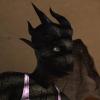Mesh design for dForce?
 Matt_Castle
Posts: 2,646
Matt_Castle
Posts: 2,646
I've been trying to improve my mesh modelling skills, particularly regards dForce, with the possible end goal of becoming a PA.
There's not really much information out there on designing mesh for dForce, but what I'm discovering so far is that it doesn't seem to particularly like tripoints where three edges meet at the same vertex, as these often tend to become lumps on (or in) the surface during simulation. The surrounding faces pull together, creating slack in the mesh.
However, unless you're creating a very simple shape, you either need tripoints, or triangular faces in the mesh (which won't be able to shear in dForce). Is there a particular way to approach tri-points to make them simulate better, or is there an entirely different approach to mesh design that I'm missing?


Comments
@Arki goes over this is pretty good detail in the Creating for and Working with dForce tutorial. Basic points:
As for edge density reduction, Max Hancock's video tutorials on modeling in Hexagon have several great tips on edge controls and flows which work no matter what modeling tool you're using. In particular the video below talks about some of the ways to reduce edges and how to make sure they keep flowing properly.
Well, I have to admit that my modelling skills have never benefitted from formal tuition, but I'm not entirely sure how to approach a complex mesh without resorting to either poles or tris/n-gons; I know of no other ways to add faces from one row to the next, and my understanding is that for good results with dForce, you want to maintain a roughly consistent mesh density, so just changing face size doesn't help much either.
I've done some retopologising that's somewhat improved the results, as dForce seems to get better results when poles have 5 or 6 points than just three, although I suspect there's still going to be a lot more trial and error in my immediate future.
Here is a refernce sheet I made for ways to reduce edge flows while maintaining good topology based on the suggestions Max provides in the video I linked above. Some of them do still use t-verts, but I imagine that there are options here that would let you flow better and add more geometry where you need it.
Those could well be useful, although it may be a challenge to use some of them without either considerably upping the mesh density or sacrificing important face loops, both of which would be big compromises on the simulation.
What I'm currently trying to work on is an underwear set that uses dForce to get elasticated edges and straps to taughtly fit the contours of the character - and preferably as wide a range of characters as possible, without requiring a new corrective morph for every extreme fantasy morph out there. (As I do a lot of contemporary fantasy). That means I don't really want edges cutting across these loops, so there's only certain places I can reasonably add or remove geometry.
I'm making progress though.